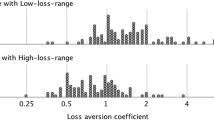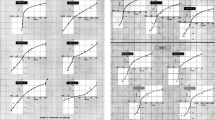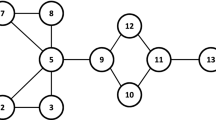Abstract
College students participated as a group in a point-loss minimization game as well as in a point-gain maximization game. The rule of the maximization game was similar to that in previous studies of human group choice (e.g., Kraft and Baum Journal of the Experimental Analysis of Behavior, 76, 21–42, 2001). In particular, each participant in the maximization game could earn points by choosing 1 of 2 colors (red or blue). A certain number of points were allocated to each color, and the participant shared the points with the other people who chose the same color. In the minimization game, on the other hand, each of the participants had 3,000 points at the beginning of the game, and the goal was to minimize the point loss: The amount of points to be lost in each trial was computed by multiplying the points allocated to the chosen color by the number of people who chose that color. The ideal distribution of participants was observed not only in the maximization game but also in the minimization game.



Similar content being viewed by others
References
Baum, W. M. (1974). On two types of deviation from the matching law: bias and undermatching. Journal of the Experimental Analysis of Behavior, 22, 231–242. doi:10.1901/jeab.1974.22-231.
Baum, W. M. (1979). Matching, undermatching, and overmatching in studies of choice. Journal of the Experimental Analysis of Behavior, 32, 269–281. doi:10.1901/jeab.1979.32-269.
Baum, W. M., & Kraft, J. R. (1998). Group choice: competition, travel, and the ideal free distribution. Journal of the Experimental Analysis of Behavior, 69, 227–245. doi:10.1901/jeab.1998.69-227.
Bertram, B. C. R. (1978). Living in groups: Predators and prey. In J. R. Krebs & N. B. Davies (Eds.), Behavioural ecology: An evolutionary approach (pp. 64–96). Oxford: Blackwell.
Fagen, R. (1987). A generalized habitat matching rule. Evolutionary Ecology, 1, 5–10. doi:10.1007/BF02067264.
Fishburn, P. C., & Kochenberger, G. (1979). Two-piece von Neumann-Morgenstein utility functions. Decision Sciences, 10, 503–518. doi:10.1111/j.1540-5915.1979.tb00043.x.
Fretwell, S. D., & Lucas, H. L., Jr. (1970). On territorial behavior and other factors influencing habitat distribution in birds: I. Theoretical development. Acta Biotheoretica, 19, 16–36. doi:10.1007/BF01601953.
Galanter, E., & Pliner, P. (1974). Cross-modality matching of money against other continua. In H. R. Moskowitz, B. Scharf, & J. C. Stevens (Eds.), Sensation and measurement: Papers in honor of S. S. Stevens (pp. 65–76). Dordrecht: Reidel. doi:10.1007/978-94-010-2245-3_6.
Goldstone, R. L., & Ashpole, B. C. (2004). Human foraging behavior in a virtual environment. Psychonomic Bulletin & Review, 11, 508–514. doi:10.3758/BF03196603.
Goldstone, R. L., Ashpole, B., & Roberts, M. E. (2005). Knowledge of resources and competitors in human foraging. Psychonomic Bulletin & Review, 12, 81–87. doi:10.3758/BF03196350.
Herrnstein, R. J. (1961). Relative and absolute strength of response as a function of frequency of reinforcement. Journal of the Experimental Analysis of Behavior, 4, 267–272. doi:10.1901/jeab.1961.4-267.
Herrnstein, R. J. (1970). On the law of effect. Journal of the Experimental Analysis of Behavior, 13, 243–266. doi:10.1901/jeab.1970.13-243.
Houston, A. I. (2008). Matching and ideal free distributions. Oikos, 117, 978–983. doi:10.1111/j.0030-1299.2008.16041.x.
Kahneman, D., & Tversky, A. (1979). Prospect theory: an analysis of decision under risk. Econometrica, 47, 263–291. doi:10.2307/1914185.
Kennedy, M., & Gray, R. D. (1993). Can ecological theory predict the distribution of foraging animals? A critical analysis of experiments on the ideal free distribution. Oikos, 68, 158–166. doi:10.2307/3545322.
Kraft, J. R., & Baum, W. M. (2001). Group choice: the ideal free distribution of human social behavior. Journal of the Experimental Analysis of Behavior, 76, 21–42. doi:10.1901/jeab.2001.76-21.
Kraft, J. R., Baum, W. M., & Burge, M. J. (2002). Group choice and individual choices: modeling human social behavior with the ideal free distribution. Behavioural Processes, 57, 227–240. doi:10.1016/S0376-6357(02)00016-5.
Madden, G. J., Peden, B. F., & Yamaguchi, T. (2002). Human group choice: discrete-trial and free-operant tests of the ideal free distribution. Journal of the Experimental Analysis of Behavior, 78, 1–15. doi:10.1901/jeab.2002.78-1.
Pulliam, H. R., & Caraco, T. (1984). Living in groups: Is there an optimal group size? In J. R. Krebs & N. B. Davies (Eds.), Behavioural ecology: An evolutionary approach (2nd ed., pp. 122–147). Oxford: Blackwell.
Roberts, M. E., & Goldstone, R. L. (2009). Sub-optimalities in group foraging and resource competition. Proceedings of the 31st Annual Conference of the Cognitive Science Society, 2371–2377.
Sokolowski, M. B. C., Tonneau, F., & Baqué, E. F. (1999). The ideal free distribution in humans: an experimental test. Psychonomic Bulletin & Review, 6, 157–161. doi:10.3758/BF03210824.
Urata, T., Shiota, T., & Nakajima, S. (2003). The ideal free distribution in human group choice and between-trial switching behavior of the individual participants. Proceedings of the 21st Annual Convention of the Japanese Association for Behavior Analysis, p. 42.
Yamaguchi, T., & Ito, M. (2006). An experimental test of the ideal free distribution in humans: the effects of reinforcer magnitude and group size. Japanese Journal of Psychology, 76, 547–553. doi:10.4992/jjpsy.76.547.
Acknowledgments
The first author designed and supervised the experimentation, reanalyzed the data, and prepared the manuscript with a grant from the MEXT (Ministry of Culture, Sports, Science and Technology, Japan) for Strategic Formation of Research Bases at Private Universities.
Author information
Authors and Affiliations
Corresponding author
Additional information
Experiments 1 and 2 were based on graduation theses submitted in 2010 and 2011 by the second and third authors, respectively, to Kwansei Gakuin University.
Rights and permissions
About this article
Cite this article
Nakajima, S., Suzuki, C. & Hirata, K. Human Group Choice in Loss Minimization and Gain Maximization Games. Psychol Rec 64, 63–69 (2014). https://doi.org/10.1007/s40732-014-0014-2
Published:
Issue Date:
DOI: https://doi.org/10.1007/s40732-014-0014-2




